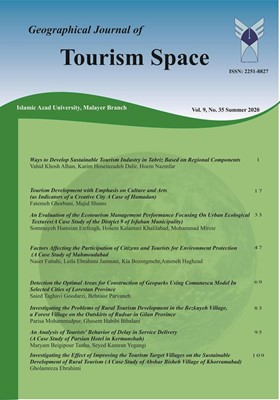Tourism Development with Emphasis on Culture and Arts (as Indicators of a Creative City a Case of Hamadan)
Subject Areas :
Fatemeh Ghorbani saberx
1
,
Mejid Shams
2
1 - dfg
2 - Full Professor of Geography ; Malayer Branch Islamic Azad University
Received: 2020-08-19
Accepted : 2020-09-06
Published : 2020-08-22
Keywords:
Tourism,
Hamedan,
Creative City,
art and culture,
Abstract :
Creative city policy can increase cultural assets and help shift from previous production models, which were largely dependent on production, to a more service-oriented and sustainable model. This leads to an increase in the number of visitors, consumption, and ultimately to the preservation of those urban uses. Proximity to cultural facilities not only increases the economic productivity of creativity, but also increases the feelings of tourists towards the city. In this research, the aim is to attract the development of tourism by considering arts and culture as the characteristics of a creative city. In the present study, the combined method has been used. The three components of economics, politics and design along with the indicators have been localized and identified by the authors through reviewing previous studies. In inferential statistics method, structural equation modeling technique, Lisrel software 54.8, and path analysis have been used. The results showed that all variables show a high correlation with their respective structures. It was shown that the obtained factor loads are significant for all obvious variables at the level of 0.05. Furthermore, all three components have been discussed according to the tourism conditions of Hamedan.
References:
ابراهیمی، مهران (1387). نشست شهر خلاق: مفاهیم، سیاستها، مطالعه موردی از شهرهای موفق و ناموفق، مرکز مطالعات و برنامهریزی شهر تهران، فرهنگسرای نیاوران، تهران.
خان سفید، مهدی (1391). مدیریت شهری و شهر خلاق، ویژه نامه منظر، شماره 19، تابستان، صص 95-92.
رحیمی، محمد؛ مردعلی، محسن؛ داها، الهامغ و فلاح زاده، عبدالرسول (1392). شهر خلاق (مبانی نظری و شاخصها)، مرکز مطالعات و برنامهریزی شهر تهران، نشریه دانش شهر، شماره 196، ص 1.
سند چشم انداز توسعه گردشگری مصوب هیأت وزیران، (1384).
قربانی، رسول، حسینآبادی، سعید، طورانی، علی (1392). شهرهای خلّاق، رویکردی فرهنگی در توسعه شهری، نشریه مطالعات جغرافیایی مناطق خشک، دوره 3، شماره 11.
کلانتری، بهرنگ؛ یاری قلی، وحید و رحمتی، اکبر (1391). فضای جمعی و شهر خلاق، ویژهنامه منظر، شماره 19، صص 79-49.
لطفی، سهند. (1391). بازآفرینی شهری فرهنگ مبنا: تأملی بر بنُ مایههای فرهنگی و کُنش بازآفرینی. نشریه هنرهای زیبا، شماره 45، 60-47.
یوسفی،ر، پیلهور، ع، احمدی، م، هاشمی، ا. (1393). شهر خلاق الگویی برای توسعه پایدار شهری، چهارمین کنفرانس بینالمللی توسعه پایدار و عمران شهری مؤسسه آموزش عالی دانش پژوهان، اصفهان، ایران.
Anderson, A. R., Wallace, C., & Townsend, L. (2016). Great expectations or small country living? Enabling small rural creative businesses with ICT. Sociologia Ruralis, 56(3), 450–468.
Bowen, D. (2002). Research through participant observation in tourism: A creativesolution to the measurement of consumer satisfaction /dissatisfaction (CS/D) amongtourists, Journal of Travel Research, 41(1): 4-14.
Bourdreau, A., Keil, R., & Young, D. (2009). Changing Toronto: Governing urban neoliberalism. Toronto, ON: University of Toronto Press.
Comunian, R. (2011). Rethinking the creative city: the role of complexity, networks and interactions in the urban creative economy. Urban Studies, 48(6), 1157–1179.
Chapple, K., Jackson, S., & Martin, A. J. (2010). Concentrating creativity: The planning of formal and informal arts districts. City, Culture and Society, 1(4), 225–234.
Florida, R. L. (2002). The rise of the creative class: And how it's transforming work, leisure, community and everyday life. New York: Basic Books.
Goldberg-Miller, S. B. D., & Heimlich, J. E. (2017). Creatives' expectations: The role of supercreatives in cultural district development. Cities, 62, 120–130.
Horng, J.S., Tsai, C.Y. and Chung, Y.C. (2016b). Measuring practitioners’creativity in the Taiwanese tourism and hospitality industry, Thinking Skills and Creativity, No. 19: 269-278.
Sleuwaegen, L. and Boiardi, P. (2014). Creativity and regional innovation: Evidence from EU regions, Research Policy, 43(9): 1508-1522.
D, S., Miller, G., (2018). Creative city strategies on the municipal agenda in New York, City, Culture and Society, pp 1-12.
Quan Li, Y., Hsing Liu, C., (2016). How to establish a creative atmosphere in tourism and hospitality education in the context of China, Journal of Hospitality, Leisure, Sport & Tourism Education, 18 (2016) 9–20.
Kakiuchi, E., (2015). Culturally creative cities in Japan: Reality and prospects, City, Culture and Society, 1-8.
Kastenholz, Elisabeth (2010). ‘Cultural proximity’ as a determinant of destination image. Journal of Vacation Marketing, 16(4), 313–322.
Grodach, C., Currid-Halkett, E., Foster, N., & Murdoch, J. (2014). The location patterns of artistic clusters: A metro- and neighborhood-level analysis. Urban Studies, 51(13), 2822–2843.
Kolar, T., & Zabkar, V. (2010). A consumer-based model of authenticity: An oxymoron or the foundation of cultural heritage marketing?Tourism Management, 31(5), 652–664.
Landry, C. & Sterling, V. (2006).The Art of City- Making. London: Earth Scan.
Redaelli, E. (2016). Creative placemaking and the NEA: Unpacking a multi-level governance. Policy Studies, 37(4), 387–402
Marianov, V., & Eiselt, H. A. (2016). On agglomeration in competitive location models. Annals of Operations Research, 246, 31–55.
Wyszomirski, M. J. (2008). Field building: The road to cultural policy studies in the United States. In J. M. Cherbo, R. A. Stewart, & M. J. Wyszomirski (Eds.). Understanding the arts and creative sector in the United States (pp. 39–58). Rutgers University Press.
(2008). Creative Economy Report . UNCTAD.
_||_


